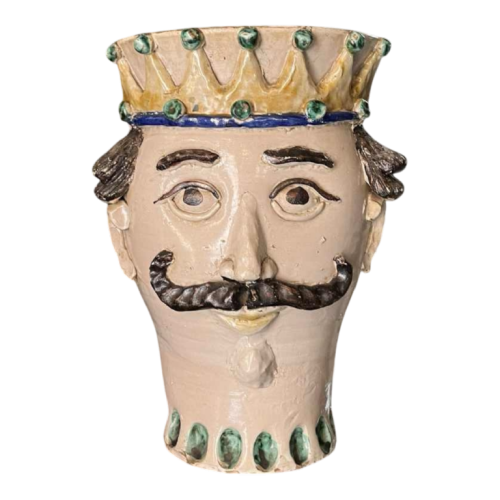Large old vase or planter bearing the painted mark JUDICE CALTAGIRONE, for Salvatore Judice.
Subsequently, this craft ceramics factory evolved and took the name of IUDICI CALTAGIRONE, probably Salvatore's sons, and therefore more recent.
This crowned anthropomorphic sculpture symbolises the head of a Moorish king and seems to date from the early 20th century or around 1940.
The tradition of ‘Teste di Moro' (Moor's heads) in Sicily is an emblematic element of Sicilian craftsmanship, particularly famous in the ceramics of Caltagirone. These vases are shaped like human heads, often used for plants, and generally depict the faces of Moors (or ‘Mori' in Italian) and young Sicilian women. They are associated with a dramatic and passionate legend that is said to have taken place in medieval times, when Sicily was under Arab influence.
- Period:19th century / 20th century.
- Dimensions (H x W x D):39 x 25 x 25 cm.
- Weight:7 Kg.
- Condition:Excellent.
- Material:Ceramic / Earthenware.
-
Price:SOLD
- Pick-up:Free.
- Belgium Delivery:20€.
- France Delivery:25€.
- Europe Delivery:30€.
- Worldwide Delivery:40€.
The legend of the ‘Teste di Moro':
According to the legend, a beautiful young Sicilian woman lived in the Arab quarter of Palermo. One day, a young Moor (a man of Arab or Berber origin) walked past her house and immediately fell in love with her beauty. Seduced, the young woman accepted his love. But she soon discovered that the man was married and had to return home to his family.
Devastated by the betrayal and the fear of losing her love, in a fit of rage she killed her lover in his sleep and cut off his head. She then turned the head into a pot, filled it with earth and planted it with basil. The basil, well fed and exposed to the sun, flourished and attracted the attention of the neighbours. Jealous of the beauty of the plant and the pot, the locals began making their own pots in the shape of human heads.
The Teste di Moro has come to symbolise passion, jealousy, betrayal and attachment to Sicily. They have become a symbol of Sicilian folklore, often seen as a representation of multicultural Sicily and its complex history marked by Norman, Arab, Byzantine and Spanish influences.
Characteristics of ‘Teste di Moro':
- The pots usually depict two distinct faces: a man, often with Moorish features (turban, beard or moustache), and a Sicilian woman with more European features and an ornate headdress.
- They are richly decorated with floral motifs, jewels, crowns and bright colours, typical of Sicilian craftsmanship.
- The pots are often made of ceramic, particularly in Caltagirone, a town renowned for its ceramic production for centuries.
Use today:
Today, Teste di Moro are prized decorative objects, symbolising traditional Sicilian art and its history. They are often used as pots for plants, particularly basil in homage to the legend, or as ornamental pieces in homes.
